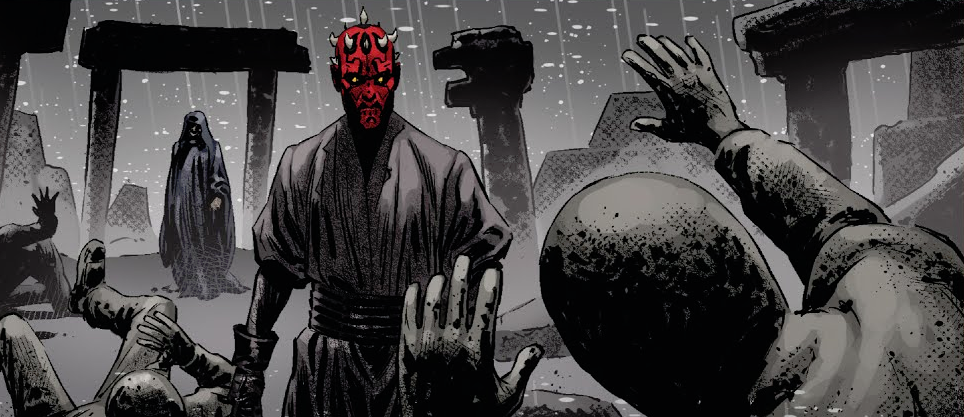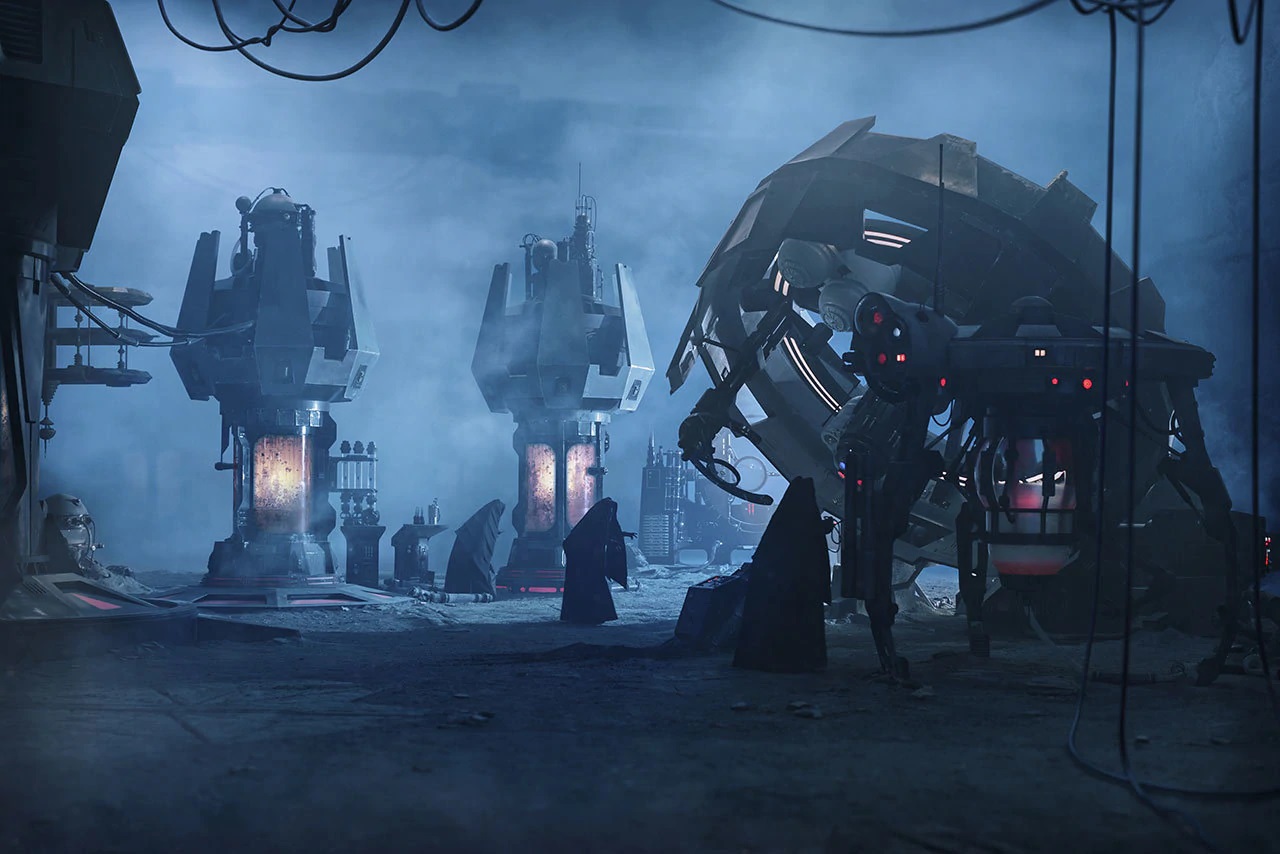However, its legacy would endure, for the Sith reobtained galactic dominance once again by the end of the Clone Wars, by founding the Galactic Empire. After the Galactic Civil War saw the fall of this government, cultists in the era of the New Republic toiled to revive the Sith Empire of old itself.

The Sith Empire's legacy survived through the Sith Lords who sought revenge against the Jedi Order
Various Sith-led governments that shared the name the Sith Empire existed long before the Galactic Civil War. The Sith Empire fought in the Great Hyperspace War against the Galactic Republic just over 5,000 years before the Imperial Era spurred by the development of the hyperdrive and the faster-than-light travel. By the Imperial Era, the now-mythological conflict was recounted in the quasi-historical Qel-Droma Epics.
According to the Qel-Droma Epics following its inception, a Sith Empire invaded the Deep Core planet of Empress Teta, with Sith forces being led by the Sith Lord Naga Sadow. The invasion led to Empress Teta to ally herself with the Jedi Order, which were mortal enemies of the Sith. The conflict resulted in the Great Hyperspace War, and the Jedi and Empress Teta supposedly managed to drive back Sadow's forces, resulting in their defeat and forcing the Sith to scatter throughout the galaxy. In another moment according to the Qel-Droma Epics, Naga Sadow decimated the Jedi world of Ossus when he triggered the stars in the Cron Cluster, resulting in the Cron Supernova which left Ossus scarred and barren.
In another instance, a Sith Empire maintained a presence on the Sith world of Malachor. A Sith Temple was situated on the surface, which contained a superweapon that was created by Darth Tanis. Eventually the Jedi Order invaded the planet in what became known as the Great Scourge of Malachor, as during the battle between the Jedi and the Sith Empire's thousands of Sith led by a Sith witch, the superweapon activated and petrified the surface, killing all of the combatants.
During or after around 4,000 BBY, a Sith Emperor ruled the Sith Empire. His chambers were once adorned by the Great Sith Wars Bas-Relief. At another point, the Sith eventually controlled the majority of the galaxy, and as such, gemstones were freely traded, although this caused a flooding of the market and the value of gemstones dropped until bans and limits were put in place. Additionally, many incarnations of the Sith Empire were built by slave labor. Serenno was a particular planet under the rule of a Sith Empire according to legend, until it was overthrown by a victorious charge led by a member of House Serenno. Around 3650 BBY, a Sith Empire participated in the Sith Wars against the Galactic Republic and the Chiss Ascendancy. Thousands of years before the Galactic Civil War that took place from 4 BBY to 5 ABY, various Sith Empires controlled the planet Auratera following an initial , and the world shifted allegiance between the Republic and the Sith throughout millennia, according to whoever controlled the nearby regions.
Additionally, according to the Qel-Droma Epics, a millennium following the Great Hyperspace War, corrupt descendants from Empress Teta's nobility created the Krath, a dark side cult, after being empowered by Sith artifacts. The Jedi Knight Ulic Qel-Droma infiltrated the group after they launched a bloody crusade against the Jedi Order, but was corrupted by the dark side of the Force and alongside the fallen Jedi Exar Kun, led the Krath. Together, the two turned Empress Teta into a stronghold for a resurgent Sith Empire.
The Brotherhood of Darkness, was an army of Sith and eventually participated in the Jedi-Sith War. The Sith Brotherhood was active on Auratera until it collapsed, becoming the last Sith Empire. The inhabitants who lived there coordinated with the Jedi to secretly alter official Republic records to misclassify the system as uninhabitable. As such, the inhabitants and the planet became nearly closed off to the rest of the galaxy, and eventually cut ties with the few remaining trading partners that they had when the Brotherhood fell. At the end of the war around 1032 BBY, the Sith Brotherhood was defeated by the Republic and the Jedi, and all the Sith were thought destroyed when they all turned on each other. Darth Bane was the sole survivor, and established the Rule of Two, which served as a doctrine for the surviving Sith for the next thousand years.
Long after the fall of the ancient Sith, Darth Maul was taken to Malachor by his Sith Master, Sith Lord Darth Sidious. Using the history of conflict between the Sith and Jedi Order to instill a sense of hatred for the Jedi in his Sith apprentice, the Dark Lord compelled Maul to inhale the ashes of the fallen Sith, causing the Dathomirian Zabrak to experience the Great Scourge of Malachor through a Force vision.
During the Republic Era, the Chiss Ascendancy maintained historical pieces in several rooms, with some dating back to the Sith Wars. Chiss officer Mitth'raw'nuru demonstrated the pieces to fellow officer Irizi'ar'alani.
Ultimately, the Sith obtained galactic dominance once again by the end of the Clone Wars after Darth Sidious, who had manipulated the war and kept his Sith identity hidden through his public persona as Supreme Chancellor Sheev Palpatine, reorganized the Republic into the Galactic Empire and proclaimed himself the Galactic Emperor with the approval of the Galactic Senate. The Galactic Empire was a fascist dictatorship, which was, unbeknownst to its subjects, secretly ruled by the Sith. During his reign, the Emperor possessed various relics and artifacts that dated back to the Sith Empire of old.
In 4 ABY, Darth Vader turned on and killed his Sith Master at the Battle of Endor in an effort to save his Jedi son, Luke Skywalker. Vader died from wounds inflicted upon him by the Emperor shortly thereafter, which rendered the Sith extinct and resulted in the fragmentation of the Galactic Empire.

The cultists on Exegol plotted to conquer the galaxy by forging a new Sith Empire on Exegol.
Unbeknownst to the galaxy at large, Darth Sidious had secretly survived by inhabiting a clone based on his original body prepared for him by the Sith loyalists of the Sith Eternal on Exegol, the legendary hidden world of the Sith. In the decades following Endor, the Sith loyalists toiled to keep the Sith Lord alive because the process to create his new body was rushed and continued developing the Final Order, a massive fleet comprised of a thousand eighty Xyston-class Star Destroyers, each armed with a superweapon capable of destroying planets like the Death Star, as well as legions of merciless Sith troopers. While Sidious plotted the destruction of the New Republic and had his surviving servants forge a remnant of the Empire into the First Order from afar, the Sith Eternal groomed Vader’s grandson Ben Solo for his role as heir to the new Sith Empire through Snoke, a creature Sidious created.
When Solo renounced the dark side, however, Sidious sought to initiate a Sith ritual that would transfer his spirit from his decaying clone into a younger and healthier vessel: his granddaughter, Rey, a Jedi Padawan trained by Luke and his twin sister and Solo’s mother Leia Skywalker Organa Solo. When she and Solo refused him, Sidious took back his old title of Emperor after draining the life force of their Force dyad when he discovered its existence, but he was ultimately killed while attempting to kill Rey to end the tale of the Rebellion as she was aided by the spirits of the Jedi who came before her. The destruction of his clone caused a massive burst of energy to release that crumbled the Sith Citadel, its debris crushing the Sith loyalists, and killed Rey, but she was resurrected by Solo, who gave his life for hers. Meanwhile, the Sith fleet was destroyed by the Resistance and their Citizens' Fleet above Exegol during the Battle of Exegol, resulting in the ultimate collapse of the Sith Empire and sparking uprisings against the First Order across the galaxy.
When a Sith Empire dominated the galaxy, gemstones were freely traded, although this caused a flooding of the market and the value of gemstones dropped until bans and limits were put in place. Additionally, trade occurred on at least one planet a Sith Empire controlled, Auratera. Sith Empires traditionally used slave labor to build themselves.
Being of the Sith, the Sith Empires used the dark side of the Force. These domains were built up through the use of slave labor, a practice that the Galactic Republic outlawed during its stewardship of the galaxy. The idea of an enormous, spacefaring, planet-destroying superweapon had dated back a millennium prior to the rise of the Galactic Empire; in the days of the Sith Empire, tyrants were playing with the idea of a weapon so powerful that it could destroy entire worlds. Although only a few superweapons were produced by the Sith Empire, it wasn't until the successes of Darth Sidious and Darth Tyranus with the outbreak of the Clone Wars that the idea came to fruition in the form of the Death Star battle station. According to legend, double-bladed lightsabers were originally constructed by Dark Lord of the Sith affiliated with the Sith Empire, long before the Imperial Era.
Empress Teta in the Deep Core was once invaded by a Sith Empire, and a millennium later became the stronghold of another Sith Empire when the Krath launched bloody crusades against the Jedi Order. Additionally, a Sith Empire maintained a presence on the Sith world of Malachor that was located in the Outer Rim Territories. Additionally, Serenno, also located in the Outer Rim, was a world under the control of a Sith Empire. At one point prior to its collapse, the Sith controlled most of the galaxy.
The Sith Empire was first identified in Star Wars canon in the 2017 novel Aftermath: Empire's End by Chuck Wendig. The Sith Empire originated in the Star Wars Legends comic Tales of the Jedi – The Golden Age of the Sith 0 on July 1, 1996.
- Star Wars: Build the Millennium Falcon 47
- Nexus of Power
- Dawn of Rebellion
- Star Wars: The Complete Visual Dictionary, New Edition
- Collapse of the Republic
- The Star Wars Book
- Star Wars: Timelines